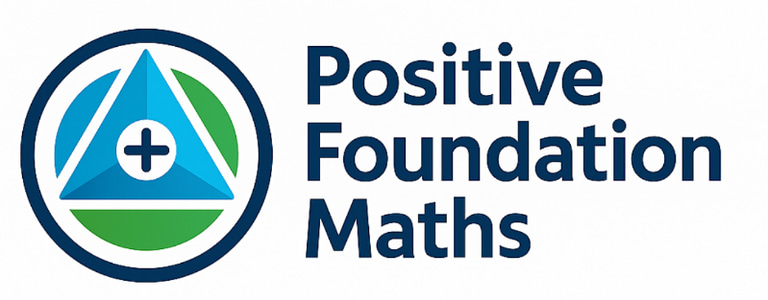
How to successfully teach maths to the lowest attaining KS4 students
The Positive Foundation Maths Project was developed during 2020. The Covid period of teaching magnified difficulties for low prior attaining students in accessing standard foundation GCSE schemes of work. Within one term of starting a Year 10 pilot programme startling positive changes were apparent in exam results and behavioural referrals. Both students and teaching staff felt the classroom atmosphere had changed for the better. Over the following three years this was extended and embedded from Year 9 to Year 11 teaching of the lowest attaining sets. This led to teaching staff engaging with a wide variety of students who had previously struggled, leading to improved satisfaction, focus, and GCSE attainment, including achieving essential pass grades in Year 11 or 12.
Jane Hardy
5/2/20254 min read


How Positive Foundation Maths can help teachers avoid burn-out
Lower prior attaining maths sets, whatever you call or label them, if you think they are only for lower ability students, think again. This site is about unravelling years of anxiety and stress from maths learning to enable real palatable success.
It doesn’t matter how SLT labels the classes, in an attempt to de-stigmatise set ranking, students know when they are in ‘bottom-set’; they know their prior test and exam scores are lower than all their friends' scores. Every. Single. Year….that they have been in school. Despite this typically 'bottom-set' kids want to 'move-up' or do more 'difficult maths' even though in the last lesson they had no idea what ⅔ meant. Schools, parents, friends, media... give constant reminders to work hard in maths. Students really want to improve their maths, even if it takes one minute in the classroom to realise that their learning journey navigates a fog of numerical torture, inevitably leading to poor behaviour for learning and limited process and logical retention.
To press reset for a foundation bottom set is a subtle process, but can be successfully achieved. Firstly teaching staff need to be prepared to get to know the students, more than just reading their endless IEPs with frankly baffling or contradictory advice (they cover all subjects and can be copied year after year since Primary School; they can at best give you shreds of advice which may or not be practical in your maths classroom). Teachers can typically be told by SLT to seat all PP and SEND students at the front of the class, and after analysing your data realise that there is only one student in the class that has either classification (and that is probably because their parents refused testing to ensure their child is not 'labelled').
Getting students to take teachers seriously requires courage to enable them to have the confidence to start maths and endurance to see it through to Year 11. To set the right tone in a class with lower prior attaining students, teachers should aim to:
not take moans about teaching methods personally and settle in for consistent teaching and behaviour for learning expectations. When students start to feel the benefit of positive foundation maths teaching methods this will mostly peter out; and if you are lucky they will actually thank you for your efforts at the end of Year 11 or 12 (if they are not too busy celebrating of course). Note that some success for some students will be a GCSE pass at KS5 with the KS4 class being the confidence stepping stone they need to move them on.
respect the fact that these students often find themselves in lower attaining sets because they are not organised. Therefore relaxing school equipment rules and not penalising for forgetting pens and calculators for example, will reduce student anxiety levels.
acknowledge the students around the school. Teachers do not need to replicate friendship, but by saying hello and/or asking about something they told you about last week when you pass them in the corridor is helpful. A lot of students would rather crawl into a dark hole to avoid doing any maths and showing others what they think they can't do. Students who are comfortable talking to teaching staff are more likely to attempt what is being asked of them in the maths classroom, and this can be achieved by teachers showing an honest interest in them.
to make the classroom a safe, drama free straight forward learning environment, with minimal distractions and easy access to equipment and books.
sit positive friendships together. More vulnerable students can be placed on the side of the classroom, where the potentially more volatile students will not get close to them. It doesn't always mean students will be placed at the front of the classroom or immediately near to teaching assistants. Yes there may be a little off task chat, but the more comfortable students are in the classroom the more maths will be attempted. It is a fine line between complete class 'off-task behaviour' and a little 'side chat' in between practising skills, but nine times out of ten this strategy will pay dividends. It takes practise to get seating plans right, teachers should expect to have a couple of shuffles at the beginning of the year and an occasional one when an unexpected new student or falling-out occurs for example.
Routines are key to getting students in the door and working on revision and 'new' tasks. Students need to feel success, www.positivefoundationmaths.co.uk breaks down these tasks and explains how to teach them. Just like successful footballers, skills practice is essential; once consistent mathematical drills are the norm, teachers can then start to connect the cognitive dots, just like the footballer is then able to play a match.
With regards to what the students don’t actually want, they don’t need an all amazing singing and dancing maths teacher. They have plenty of friends, so staff do not need to go overboard in this regard, but should be consistent and fair in the application of the school and maths class rules. Teachers that are burnt out and not present for the 99% of lessons are ineffective educators. Students need simply explained tasks so they can practise, repeat and rinse and not waste their time with superlative descriptions from reliable teachers they trust. Such students probably won’t do much or any homework, and whilst that is not something to give up on, at the same time don't over worry by its paucity. Surprisingly it is less important if the teacher can get students' attention when they are in class. The teacher really matters.
Here’s where Positive Foundation Maths comes in. Even with the most wonderful foundation GCSE maths schemes of work and supportive maths teams, there NEVER is enough suitably simplified practice material. We also know It is far more exhausting teaching maths to a lower attaining set despite there being half the number of students and more adults in a supporting role (if you are lucky) than teaching any other subject or set.
The project is here to give advice and start a repository of resources so teachers don’t reinvent wheels thereby saving vital energy to be manageably effective.
